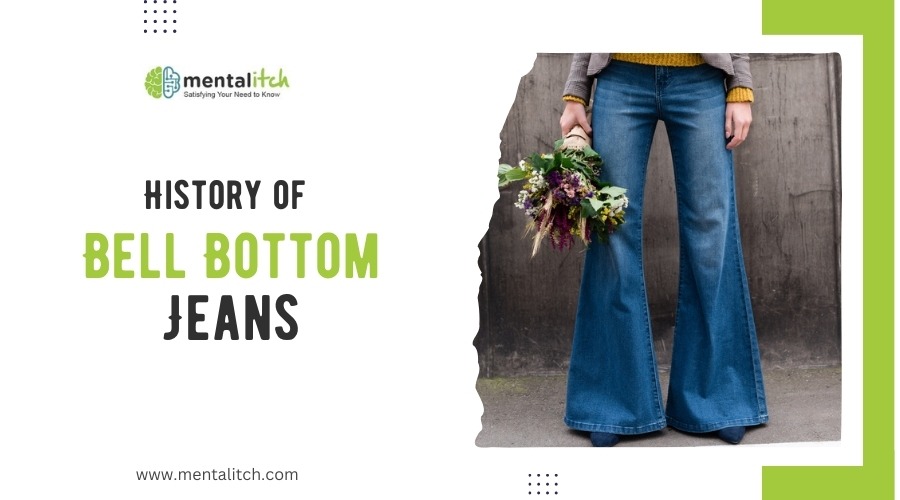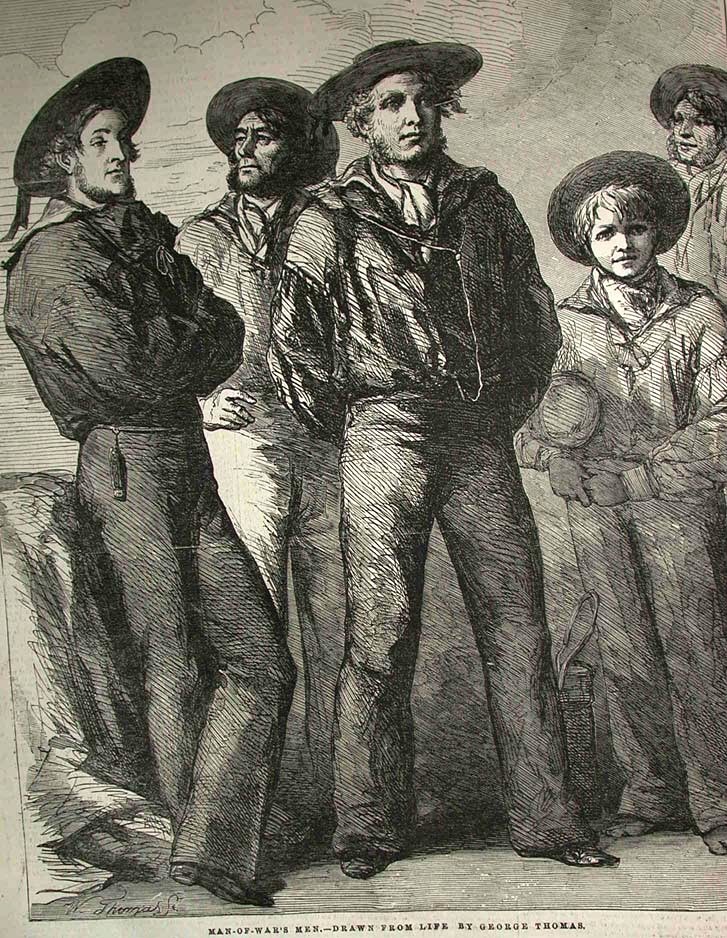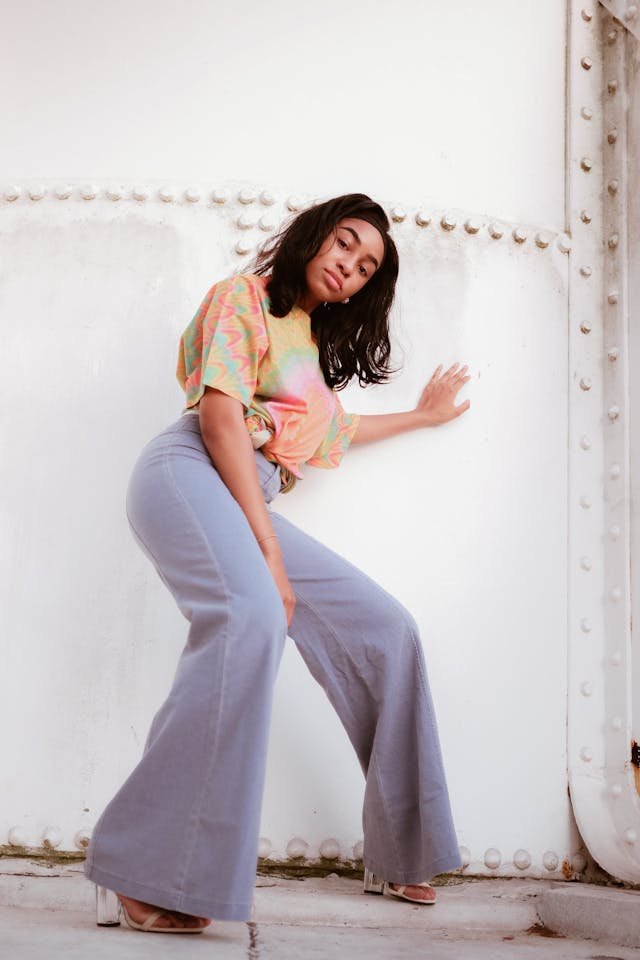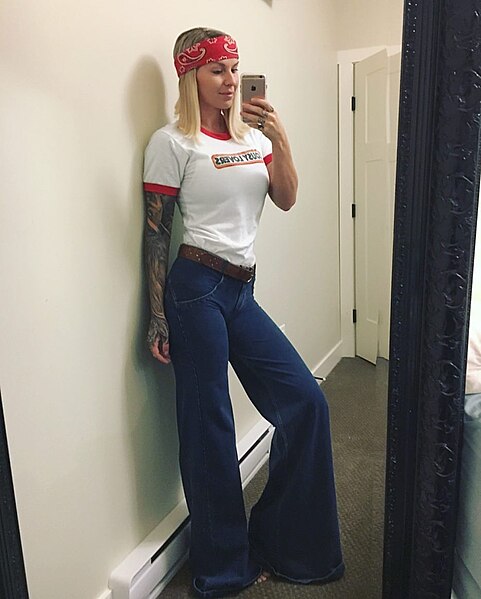As the name suggests, bell-bottoms are a form of pants that are fit from the thighs and widen from the knee downwards. The flare gives them the look of a bell, hence the name, bell-bottoms. The history of fashion has seen a variety of styles when it comes to pants/trousers. The skinnies have ruled over the fashion timeline for quite a while, the cropped pants, the straight trousers, the capris, etc. all have had their share of fame.
Early History
Bell bottom jeans aren’t a recent fad, they have a history that dates long back to the seventeenth century. Getting their significance from the 1970s, bell-bottom jeans have been an iconic trend.
Even though no one knows who invented the bell-bottom styled jeans, the earliest adoption of this trend was during the seventeenth century. It was when the U.S. Navy had no formal uniform and some sailors adopted wearing wide-legged trousers. This trend was taken up, during the War of 1812, merely on the basis of functionality and not fashion.
As history records, wearing wide-legged trousers made it easier for the sailors to roll the pants up in case of high waters. This prevented their clothes from soiling while working in muddy waters. These pants were more of just wide-legged trousers rather than properly shaped bell-bottoms. They were continuously used as part of the uniform until in 1977, they were replaced by a more conventional flare of the approved navy uniform. Even though the current uniform of the US Navy is known to be bell-bottomed, they simply just have wide legs.
During the 1920s, the bell bottoms made an entry into mainstream fashion through the unique designs of the French Designer Coco Chanel. Chanel was famous for making the women of this era come out of their corsets and dresses, and wearing loose trousers and pants. Chanel took inspiration from the loose sailor pants and introduced versions of her own such as, ’Yachting pants’ and ‘Beach Pajamas’.
Later, the bell bottom trend got famous again during the 1960s. They became a fad among both men and women. As the American youth became more involved in radical political and artistic movements, a culture of rebellion began. These young people rejected the mainstream fashion and were often tagged as ‘Bohemians’ or ‘Hippies’. They were known to shop for clothes from the cheap, Army Surplus stores, and this is where they found the Navy’s denim bell-bottoms.
Adorned with embroidery and patches, these pants represented the hippie culture. The designs soon got famous, and people started turning their straight pants into bell-bottoms by inserting a triangle of fabric into the side seam of the pants. Later, fashion designers picked up on bell-bottoms and soon the trend was selling under famous brand names.
The 1970s was the era well-known for the introduction of disco. The disco era is famous for its flared pants, wide-collars and high heeled shoes. It is this period where the bell-bottoms became a huge success. This era was known for bell-bottom jeans or pants that flared out from the bottom of the calf and had slightly curved hems. In 1971, blues rock group ‘Derek and the Dominos’ also mentioned bell-bottoms in one of their popular music singles ‘Bell Bottom Blues’.
Influence of Pop Culture
Bell-bottoms gained immense popularity through their appearances in movies and television shows. Films like “Saturday Night Fever” starring John Travolta in the late 1970s showcased the flashy and flamboyant side of bell-bottoms, making them synonymous with the disco era. Television shows such as “The Sonny and Cher Comedy Hour” also contributed to their mainstream adoption, with the duo often seen sporting flamboyant flared pants, solidifying their place in the fashion scene of the time.
The 1970s was the era well-known for the introduction of disco. The disco era is famous for its flared pants, wide-collars and high heeled shoes. It is this period where the bell-bottoms became a huge success. This era was known for bell-bottom jeans or pants that flare out from the bottom of the calf and had slightly curved hems. In 1971, blues rock group ‘Derek and the Dominos’ also mentioned bell-bottoms in one of their popular music singles ‘Bell Bottom Blues’.
The 1970s was the period when bell-bottom was introduced into mainstream fashion. The bell-bottoms also gained popularity through the famous television show ‘The Sonny and Cher Comedy Hour’. Sonny and Cher were seen wearing flared pants in this show. The hems of these pants were around 26 inches, and they typically flared from the knee down. These pants were usually made of denim, colorful satin or polyester, and have been known to be so iconic that they are considered a symbol of the 70s era.
This era also saw a variant of the bell-bottoms, known as the Loon pants which is short for Balloon Pants, but with a larger flare. Dancers in the British UK variety show were occasionally seen adorning these Loon pants. One other variant of the bell-bottoms was the Elephant bells. They became popular in the mid-to-late 1970s. They resembled Look pants, but were normally made of denim. They had a distinct flare right below the knee and often covered the wearers shoes. They were paired with platform shoes with heels at least 4 to 5 inches to keep the pants’ hems off the ground.
The versatility of bell-bottoms contributed to their appeal across genders. The wide-legged silhouette, which flared from the knee down, offered a comfortable and fluid style that appealed to individuals regardless of gender identity. This led to a widespread adoption of bell-bottoms as a unisex fashion statement.
Modern Times
Just when everyone believed that flared jeans were gone for good, bell-bottoms slowly but surely started gaining popularity again in the 1990s. The 90s fashion showed an inclination towards baggier styles so the flared trousers/pants made a comeback. In 1996, women’s bell-bottoms hit mainstream fashion once again!
However, these pants were a toned-down version of the expansive flares of the past. Referred to as ‘boot cut’, these pants had a subtle flare. The flare of the 90s was all about a slim hip and upper thigh, with a minimal flare at the bottom as opposed to the bell-bottoms of the 70s which were all about huge flares. The boot cut style ruled over the fashion for almost a decade.
The endorsement of gender-neutral fashion by celebrities and influencers further propelled its acceptance. Public figures advocating for inclusivity and breaking gender stereotypes often showcased their support by wearing and promoting unisex styles, including bell-bottom jeans, on various platforms.
The red carpet has long been a runway for showcasing the latest trends and iconic styles, and bell-bottom jeans found their way into this glamorous realm through influential fashion icons. The popularity of flared pants has been greatly aided by celebrities, who have taken them from being a casual wardrobe staple to a representation of chic, carefree style. Fashion-forward celebrities have been wearing bell-bottoms since the 1970s, making them a sought-after piece of clothing that is timeless. Let’s examine how these esteemed personalities elevated bell-bottom jeans to a classic and iconic fashion choice, both on and off the red carpet.
Today, bell-bottoms are making a comeback again. A number of designers seemed to have taken inspiration from the flares of the 70s. Even though the trend of bell-bottom jeans has been going on and off, they are never completely out of fashion. Women have been seen carrying a number of styles in the current fashion scenario. Some may be seen sporting skinnies while others may be seen wearing flares. Straight pants are also the choice of many.
Even in recent years, the resurgence of bell-bottoms owes much to their continued appearances in pop culture. Fashion-forward celebrities and influencers regularly showcase updated versions of bell-bottom jeans, sparking renewed interest in this classic style among younger generations.
Interesting Facts About Bell Bottom Jeans
Find out more about this iconic fashion staple:
- Origin in the Navy: Bell bottoms were originally worn by sailors in the U.S. and European navies in the 19th century. The wide legs allowed sailors to roll them up easily when washing decks.
- Symbol of Rebellion: In the 1960s and 1970s, they became a symbol of rebellion and counter-culture.
- Hippie Movement: Bell bottoms were closely associated with the hippie movement, representing freedom and non-conformity.
- Dancing Comfort: Their design made them ideal for dancing, which contributed to their popularity during the disco era of the 1970s.
- Retro Comebacks: Bell bottoms have seen several revivals in fashion, notably in the late 1990s and again in the 2010s.
- Celebrity Influence: Celebrities like Jimi Hendrix, Janis Joplin, and Cher popularized bell bottoms in the 1960s and 1970s.
- Variations in Flare: The width of the flare has varied over the years, from slight flares to extreme bell shapes.
- DIY Flares: It was common for individuals to create their own bell bottoms by inserting fabric triangles into the sides of their jeans.
- Fashion Versatility: Bell bottoms have been made in various fabrics, including denim, corduroy, and satin.
- Gender Neutral: They were one of the first fashion trends widely accepted for both men and women.
- Military to Mainstream: Their transition from a practical naval garment to a mainstream fashion item is a unique journey in fashion history.
- Platform Shoes Pairing: Often paired with platform shoes, bell bottoms helped create an iconic silhouette in the 1970s.
- Political Statements: Some used bell bottoms to make political statements, often featuring embroidered peace signs or anti-war slogans.
- Rise and Fall in Popularity: The popularity of bell bottoms has seen rises and falls, often reflecting broader cultural shifts.
- Influence on Modern Jeans: Modern bootcut and flared jeans owe their design to the bell bottom trend.
- Global Appeal: Bell bottoms became popular not just in the U.S., but around the world, influencing global fashion trends.
- Use in Costuming: They are a popular choice in costumes representing the 1960s and 1970s.
- Symbol of an Era: Bell bottoms are often used as a cultural symbol to represent the spirit and style of the 1970s.
- Customization: Customization with patches, embroidery, and painting was common, making each pair a personal fashion statement.
- Evolving Waistlines: Throughout their various comebacks, the rise of the waist in bell bottom jeans has shifted from high to low and back again.
Conclusion
Bell-bottom jeans, with their history of defying traditional gender associations, stand as a testament to the evolving nature of fashion. Their journey from utilitarian men’s workwear to a symbol of gender-neutral expression signifies the ongoing progress toward a more inclusive and diverse fashion industry, where clothing knows no boundaries of gender or identity.




